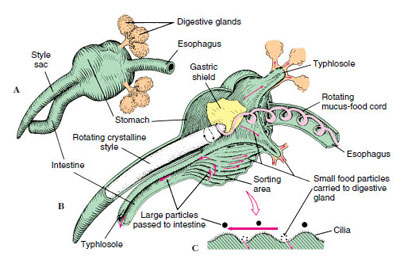
Fiddler Crabs live around Barnegat Bay ...read more
Fiddler and Ghost crabs Family Ocypodidae
Atlantic marsh fiddler crab Uca pugnax
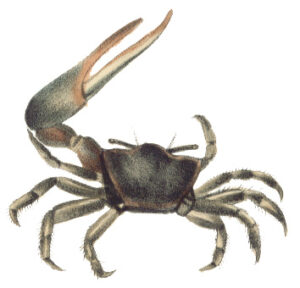 At low tide, the marshes and sand flats of the Bay teem with animals foraging for food. One of the most abundant creatures is the fiddler crab, a small, close cousin to the ghost crab.
At low tide, the marshes and sand flats of the Bay teem with animals foraging for food. One of the most abundant creatures is the fiddler crab, a small, close cousin to the ghost crab.
Male fiddlers are easy to identify by their enlarged fiddler claws, which they wave or saw back and forth in a “fiddling” motion–not to fight predators, but to attract mates and discourage rivals. Female fiddlers do not develop a large claw, so identifying their species must usually be done based on their close proximity to a male fiddler.
In addition to their distinctive claws, fiddlers are known for their interesting habit of creating tidy and sometimes elaborate burrows for mating, sleeping, remaining dormant during winter, and temporary burrows for refuge from predators during feeding times.
Fun Fact – Fiddler crabs (like all crabs) are ectothermic (cold-blooded) so they do not “hibernate” but enter a state of dormancy called diapause
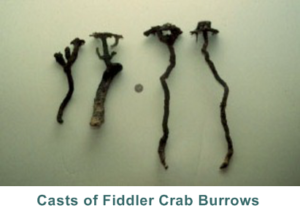 Burrows are approximately .5 inches (1.3) cm wide and are between 12 inches and 36 inches deep.
Burrows are approximately .5 inches (1.3) cm wide and are between 12 inches and 36 inches deep.
Commonly located in sandy and muddy substrates, burrows may end in a small room or be connected with other burrows. During high tide, they plug their burrows with mud. Often these burrows are found near hard structural elements or grass stems in areas of intermediate root mat density.
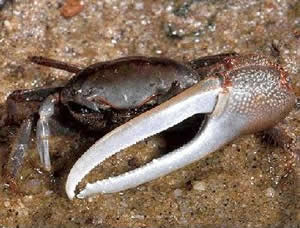 Fiddler crabs are very active during daylight hours, foraging, mating and digging burrows. At low tide they emerge from their burrows and roam over the flats in search of algae or decaying vegetation.
Fiddler crabs are very active during daylight hours, foraging, mating and digging burrows. At low tide they emerge from their burrows and roam over the flats in search of algae or decaying vegetation.
Fiddlers will roll up a small amount of mud and plug up their burrow’s opening during high tide, trapping a small pocket of air.
Unlike blue crabs, fiddlers obtain their oxygen from the atmosphere. They do have gills, which must be kept wet to remain functional.
In winter fiddlers stay in their burrows and the following spring reappear from their submerged homes on the flats in droves.
Fun Fact – A male fiddler crab’s major (larger) claw can be either left-handed or right-handed.
Females have the advantage when it comes to finding and eating food, because both their claws are small and dexterous. Unlike other crabs, which use their claws or chelipeds to crush food or to grasp objects, the fiddlers’ claws are used to pick up sediment, which they scrape with their mouths for food particles derived from organic matter and unicellular plants.
The small claws help the females sift through the sediment, which they then redeposit on the ground in the form of pellets after removing nutrients.
Fiddlers often eat in a puddle of water to help separate the food from the sediment. The adult male’s large claw inhibits the entire feeding process, so it must generally eat twice as much or twice as fast in order to obtain the same nutrition.
Fun Fact – If a male fiddler crab loses its major claw, the remaining claw grows to the same size as the lost (major) claw and the claw that is regenerated becomes the smaller claw.
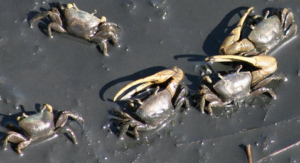 Fiddler crabs also help to maintain larger marsh ecological processes in consuming detritus from cord grass and other plants. They contribute to the aeration of soil around marsh grasses, and thus support their growth, and stimulate the turnover of important nutrients in the soil.
Fiddler crabs also help to maintain larger marsh ecological processes in consuming detritus from cord grass and other plants. They contribute to the aeration of soil around marsh grasses, and thus support their growth, and stimulate the turnover of important nutrients in the soil.
Fiddlers additionally play an important role in the food web by providing food for many other large predators, including blue crabs, colonial waterbirds such as egrets and herons and small mammals such as raccoons.
Fiddler crabs exhibit many interesting forms of behavior, but none more interesting than the mating ritual. In summer, fiddlers tend to breed about every two weeks.
During this period the male fiddler digs, maintains and defends a tidy cylindrical burrow. When looking for a mate, he stands near the edge of the burrow, often alongside a string of other males and their (similarly well-maintained) burrows, while the females, returning from foraging, walk past.
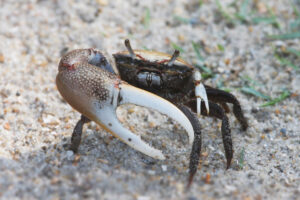 The male waves his large fiddler claw until he attracts the attention of an interested female, who then stares at him for a short period.
The male waves his large fiddler claw until he attracts the attention of an interested female, who then stares at him for a short period.
The male resumes his claw-waving, and if the female remains receptive, the male runs toward her, then runs back to his burrow, and repeats this motion several times until she either moves on or follows him to the burrow.
The male then partly enters the burrow and drums the edge with his claw. If the female decides to enter the burrow, the male leads her to the terminal “room”, returns to the opening to plug up the entrance with sand or mud, and descends to the female again to mate. The female incubates her eggs (or “sponge“) for two weeks and returns to the surface to release her eggs in the water, where they will hatch and develop into juvenile crabs.
Useful Information Website:
13 Fascinating Freshwater Crabs For Your Aquarium – Freshwater crabs tend to be small, ideal for a lot of tank sizes.
